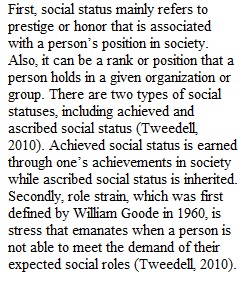


Q Getting Started Your social status, your role, and the conflicts between them are circumscribed by society. During your interactions with others, you learn about status and what it means, as well as what your own status is. You also become more or less enmeshed in certain roles: student, child, adult, non-professional, professional, mentor, expert, and so forth. These roles will shift and change as you get older, complete certain milestones (such as graduate with a college degree or become a parent), and gain experience in a particular job or field. So, too, will you likely be involved in organizations that comprise groups. The organizations and the way they are structured will impact your status and role, as well as the types of conflicts you may experience (more like tensions or pressures than “confrontations” in sociology). Finally, an important concept in sociology is that we all contribute to the “construction of reality.” What this means in simple language is that your perspectives and thoughts about others and the world will differ from everyone else’s (although there will be some overlap). Each person has a unique view or perspective of the world. Through our conversations and written materials, we each bring our perspectives to bear. You will integrate some of these into your views of the world, and exclude others based on your values, biases, beliefs, and culture (among other things). In this assignment, you will have the opportunity to examine each of these in more detail, which will also influence your construction of reality! Upon successful completion of this assignment, you will be able to: • Describe various social statuses and roles and discuss how they conflict or produce strain. • Identify ways in which reality is socially constructed. • Describe ways that a Christian organization can help to humanize bureaucracy and prevent alienation. • Explain the difference between primary and secondary groups. ________________________________________ Background Information This assignment will enable you to think more critically about social constructions of reality, groups, hierarchies, bureaucracies, and other sociological concepts and perspectives, as described in your textbook. ________________________________________ Instructions 1. Review the rubric to make sure you understand the criteria for earning your grade. 2. In your textbook, Sociology: A Christian Approach for Changing the World, review Chapter 5, “Social Structure, Groups, and Organizations.” 3. Watch the video Social Stratification(new tab). 4. Write a three- to four-page paper addressing the following: a. Define social status, role strain, and role conflict. b. Give some examples of your statuses and the accompanying roles you play. Discuss role strain and role conflict. What are ways to resolve role strain/conflict? c. Download and review the Concept Map(Word document) file. Provide one to two examples of ways in which reality is socially constructed. d. Cite personal examples of ways in which bureaucracy alienates. What are ways to humanize bureaucracy? What does it mean to have a Christian organization? e. Explain the difference between primary and secondary groups. 5. This assignment, you must submit your paper to Tutor.com for writing feedback. a. Access Tutor.com in your course homepage by clicking on the Tutor.com icon in the Tools for Success! Widget on the right hand side of the page. b. Once on the Tutor.com homepage, select "Submit a paper for review" from the menu across the top. c. Complete the form. (Under "Please describe your assignment and any instructions..." paste instructions 2 and 3 in the box). Upload the document, and submit. i. Special Notes: For more support assistance, complete the Tutoring Information Form on the Academic Support & Tutoring page. ii. A detailed writing review will be returned to your Tutor.com account within 12 hours (usually under four hours). To access, click "My Account" and select "My Sessions." The name of the tutor will appear along with three options: Summary Feedback Form, Original Document, and Reviewed Document. The Summary Feedback Form can be downloaded as a PDF. The Original Document link opens the paper, and the Reviewed Document link will open the tutor-reviewed paper with comments on the right hand side. 6. By incorporating appropriate suggestions from the Tutor.com feedback, please edit your paper to produce a final draft. 7. You must submit both your final draft AND a copy of your tutoring feedback. Therefore, two documents are required to be submitted for this assignment. 8. When you have finished your assignment, save a copy for yourself and submit a copy to your instructor using the Assignment submission page by the end of the workshop. 9. The three- to four-page paper should be in 12-point Times New Roman font and double-spaced. Follow APA formatting. Correct use of citations and references is required. 10. When you have finished your assignment, save a copy for yourself and submit a copy to your instructor using the Assignment submission page by the end of the workshop.
View Related Questions